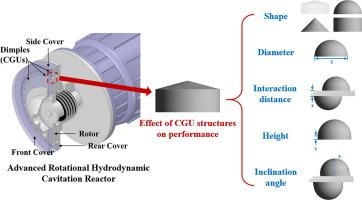Chemical Engineering Journal ( IF 13.3 ) Pub Date : 2021-01-23 , DOI: 10.1016/j.cej.2021.128600 Xun Sun , Weibin You , Xiaoxu Xuan , Li Ji , Xingtao Xu , Guichao Wang , Shan Zhao , Grzegorz Boczkaj , Joon Yong Yoon , Songying Chen

|
The advanced rotational hydrodynamic cavitation reactors (ARHCRs) that appeared recently have shown obvious advantages compared with conventional devices in process intensifications. In ARHCRs, the cavitation generation unit (CGU) located on the rotor and stator basically determines their performance. For the first time, the present study investigated the effect of the CGU structure on the performance of a representative ARHCR by utilizing computational fluid dynamics. The amount of generated cavitation and required torque of the axis for various shapes, diameters, interaction distances, heights, and inclination angles of the CGU were analyzed. The results indicate that the interaction-type ARHCR (cavitation is generated by stator-rotor interaction) was far superior to the non-interaction type one. In addition, the hemisphere-shaped CGU demonstrates the best performance compared with that with cone-cylinder, cone, and cylinder shapes. Moreover, by evaluating the effects of various geometrical factors, the hemisphere-shaped CGU with a diameter of 12 mm, interaction distance of 1 mm, height of 1 mm, and inclination angle of 10° achieved the highest performance. The reasons leading to different performance were elaborated in accordance with the flow and pressure field distributions, as well as the generated cavitation patterns. The findings of this work can strongly support the fundamental understanding, design, and application of ARHCRs for process intensifications.
中文翻译:

空化生成单元结构对用于过程强化的先进水力空化反应器性能的影响
最近出现的先进的旋转水力空化反应器(ARHCR)在工艺强化方面与常规装置相比已显示出明显的优势。在ARHCR中,位于转子和定子上的气蚀发生单元(CGU)基本上决定了它们的性能。本研究首次通过利用计算流体动力学研究了CGU结构对代表性ARHCR性能的影响。分析了CGU的各种形状,直径,相互作用距离,高度和倾斜角度所产生的气蚀量和所需的轴扭矩。结果表明,相互作用型ARHCR(通过定子-转子相互作用产生的气蚀)远远优于非相互作用型ARHCR。此外,与圆锥,圆柱和圆柱形状相比,半球形CGU表现出最好的性能。此外,通过评估各种几何因素的影响,直径为12 mm,相互作用距离为1 mm,高度为1 mm,倾斜角度为10°的半球形CGU达到了最高性能。根据流场和压力场的分布以及所产生的气穴现象,详细阐述了导致不同性能的原因。这项工作的发现可以强烈支持ARHCR在过程强化方面的基本理解,设计和应用。直径为12毫米,相互作用距离为1毫米,高度为1毫米,倾斜角度为10°的半球形CGU的性能最高。根据流场和压力场的分布以及所产生的气穴现象,详细阐述了导致不同性能的原因。这项工作的发现可以强烈支持ARHCR在过程强化方面的基本理解,设计和应用。直径为12毫米,相互作用距离为1毫米,高度为1毫米,倾斜角度为10°的半球形CGU的性能最高。根据流场和压力场的分布以及所产生的气穴现象,详细阐述了导致不同性能的原因。这项工作的发现可以强烈支持ARHCR在过程强化方面的基本理解,设计和应用。





















































 京公网安备 11010802027423号
京公网安备 11010802027423号